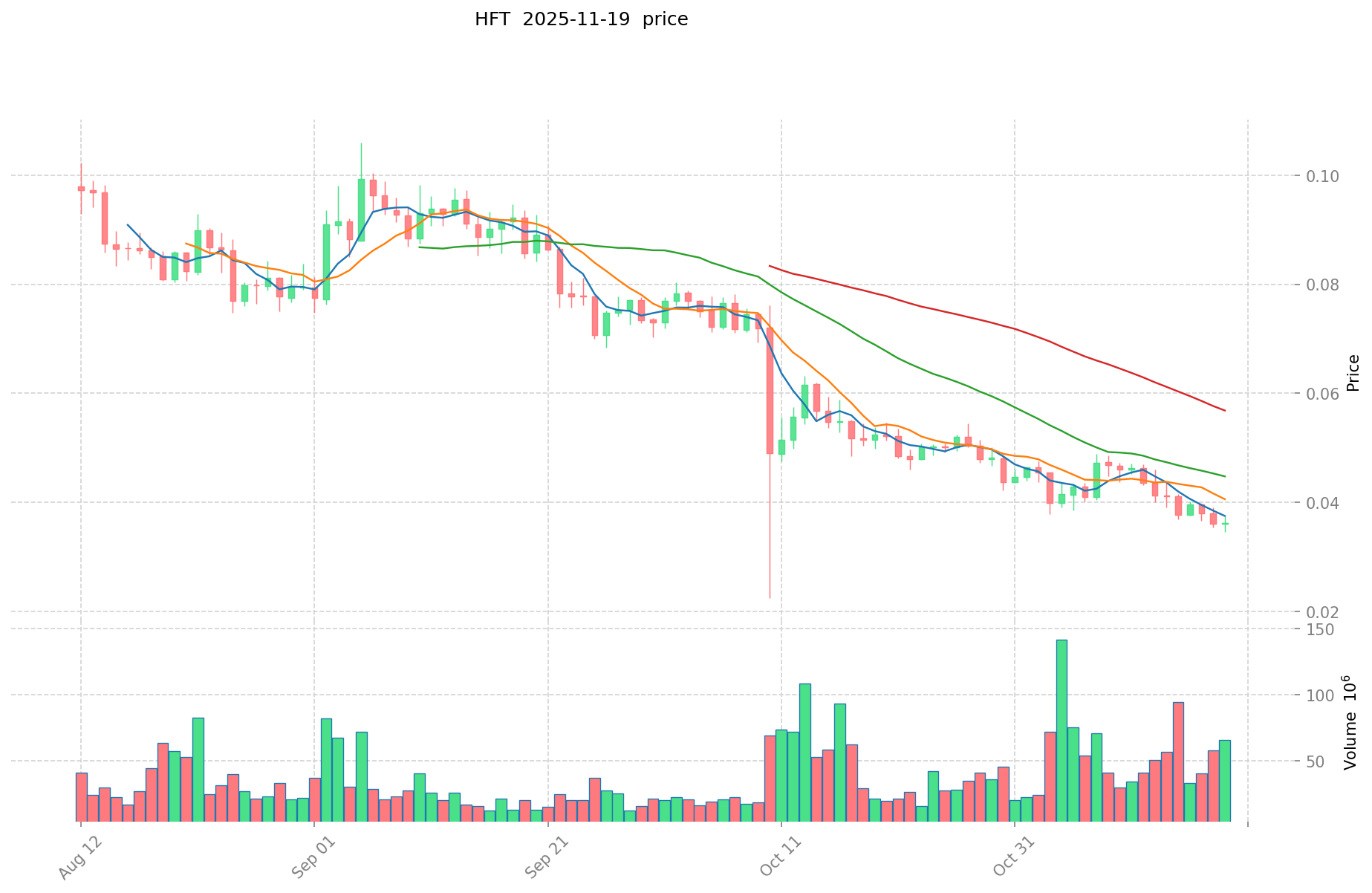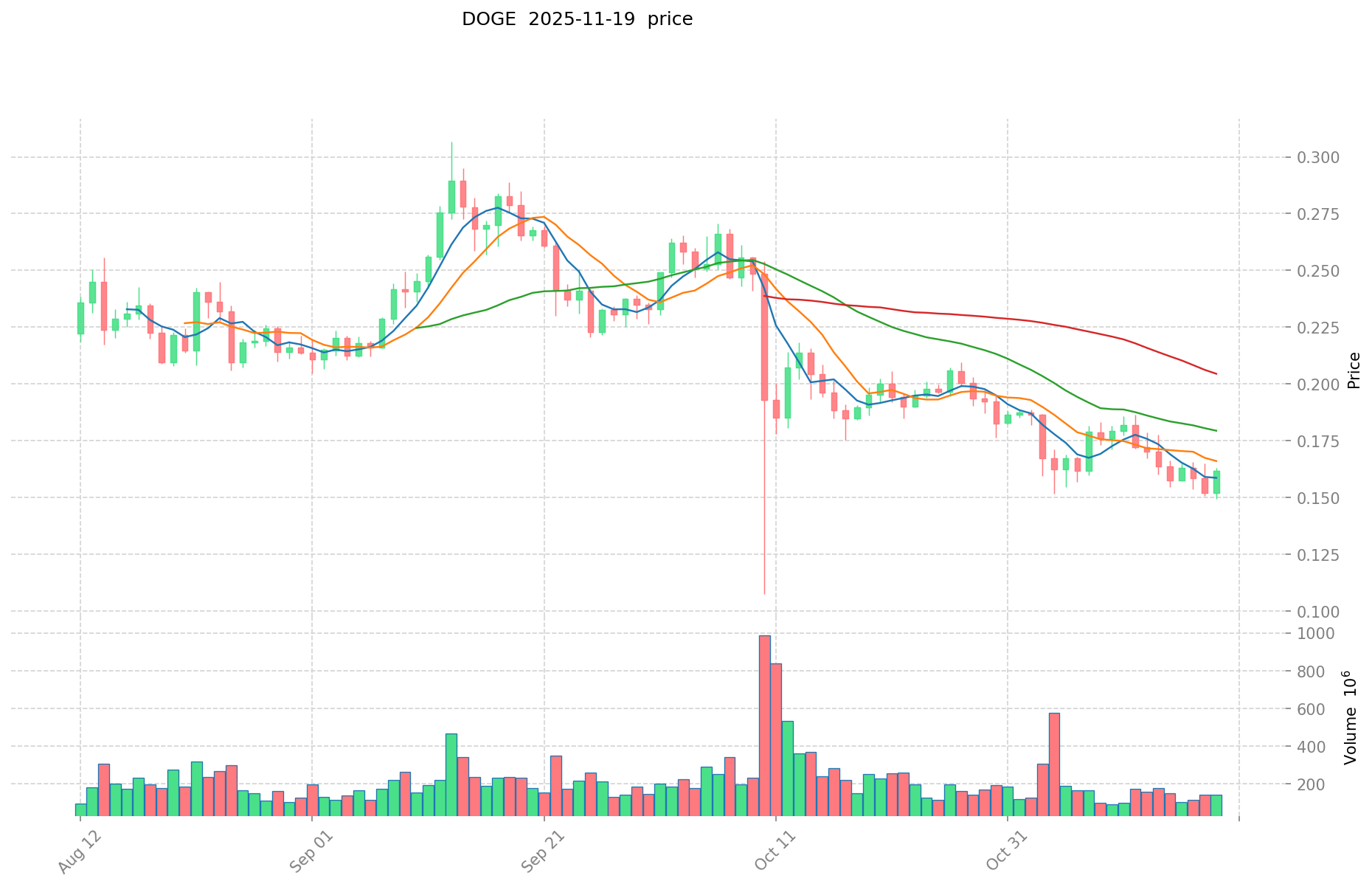HFT vs DOGE: The Battle of High-Frequency Trading and Memecoin Volatility
Introduction: HFT vs DOGE Investment Comparison
In the cryptocurrency market, the comparison between Hashflow (HFT) and Dogecoin (DOGE) has been an unavoidable topic for investors. The two not only show significant differences in market cap ranking, application scenarios, and price performance but also represent different positions in the crypto asset landscape.
Hashflow (HFT): Since its launch, it has gained market recognition for its universal zk-settlement layer and as one of DeFi's largest RFQ liquidity sources.
Dogecoin (DOGE): Introduced in 2013, it has been hailed as a fun, light-hearted cryptocurrency, becoming the second-largest virtual currency in terms of user base after Bitcoin.
This article will comprehensively analyze the investment value comparison between HFT and DOGE, focusing on historical price trends, supply mechanisms, institutional adoption, technological ecosystems, and future predictions, aiming to answer the question most concerning to investors:
"Which is the better buy right now?" I. Price History Comparison and Current Market Status
HFT and DOGE Historical Price Trends
- 2022: HFT reached its all-time high of $3.61 on November 7, 2022.
- 2021: DOGE surged to its all-time high of $0.731578 on May 8, 2021, driven by social media hype and celebrity endorsements.
- Comparative analysis: In the recent market cycle, HFT has fallen from its all-time high to a low of $0.02468737, while DOGE has shown more stability, maintaining a higher market cap.
Current Market Situation (2025-11-19)
- HFT current price: $0.03574
- DOGE current price: $0.15859
- 24-hour trading volume: HFT $2,177,060.64 vs DOGE $23,204,674.86
- Market Sentiment Index (Fear & Greed Index): 15 (Extreme Fear)
Click to view real-time prices:
- Check HFT current price Market Price
- Check DOGE current price Market Price


Investment Value Factors: HFT vs. DOGE
Supply Mechanism Comparison (Tokenomics)
- HFT: Relies on algorithm-based trading strategies rather than token supply; value derived from execution speed and market inefficiencies
- DOGE: Inflationary supply with approximately 5 billion new coins minted annually; no supply cap unlike Bitcoin
- 📌 Historical Pattern: DOGE's price movements often follow social media trends and celebrity endorsements rather than supply mechanics, while HFT profits from market volatility regardless of direction
Institutional Adoption and Market Applications
- Institutional Holdings: HFT dominates institutional participation through specialized trading firms and hedge funds; DOGE has limited institutional backing beyond retail speculation
- Enterprise Adoption: HFT serves critical market-making functions in exchanges; DOGE has seen sporadic commercial acceptance for payments but lacks significant business utility
- Regulatory Stance: Governments increasingly scrutinize HFT practices for market manipulation concerns; DOGE faces general cryptocurrency regulatory challenges with less specific targeting
Technology Development and Ecosystem
- HFT Technology: Continuous advancement in low-latency infrastructure, ASIC chips, and machine learning algorithms driving competitive advantage
- DOGE Development: Minimal technical updates compared to other cryptocurrencies; relies primarily on Dogecoin Foundation's initiatives for improvement
- Ecosystem Comparison: HFT integrated across traditional financial markets; DOGE ecosystem primarily centers around community activities, tipping, and charitable donations
Macroeconomic Factors and Market Cycles
- Inflation Performance: HFT strategies can adapt to inflationary environments through tactical positioning; DOGE lacks inherent inflation protection mechanisms
- Monetary Policy Impact: Interest rate changes directly affect HFT borrowing costs and strategies; DOGE price movements correlate more with general cryptocurrency market sentiment
- Geopolitical Considerations: Market volatility from global events creates opportunities for HFT; DOGE occasionally benefits from capital flight scenarios but with higher risk profile
III. 2025-2030 Price Prediction: HFT vs DOGE
Short-term Prediction (2025)
- HFT: Conservative $0.0296 - $0.0357 | Optimistic $0.0357 - $0.0532
- DOGE: Conservative $0.0982 - $0.1585 | Optimistic $0.1585 - $0.2282
Mid-term Prediction (2027)
- HFT may enter a growth phase, with estimated price range $0.0441 - $0.0719
- DOGE may enter a stabilization phase, with estimated price range $0.1988 - $0.2323
- Key drivers: Institutional capital inflow, ETF, ecosystem development
Long-term Prediction (2030)
- HFT: Base scenario $0.0446 - $0.0875 | Optimistic scenario $0.0875 - $0.1138
- DOGE: Base scenario $0.1851 - $0.2682 | Optimistic scenario $0.2682 - $0.3863
Disclaimer: This analysis is for informational purposes only and should not be considered as financial advice. Cryptocurrency markets are highly volatile and unpredictable. Always conduct your own research before making any investment decisions.
HFT:
| 年份 | 预测最高价 | 预测平均价格 | 预测最低价 | 涨跌幅 |
|---|---|---|---|---|
| 2025 | 0.0532973 | 0.03577 | 0.0296891 | 0 |
| 2026 | 0.0547763895 | 0.04453365 | 0.032064228 | 25 |
| 2027 | 0.0719997786375 | 0.04965501975 | 0.0441929675775 | 39 |
| 2028 | 0.084550084879312 | 0.06082739919375 | 0.038929535484 | 71 |
| 2029 | 0.102491126271509 | 0.072688742036531 | 0.057424106208859 | 104 |
| 2030 | 0.113866914400226 | 0.08758993415402 | 0.04467086641855 | 146 |
DOGE:
| 年份 | 预测最高价 | 预测平均价格 | 预测最低价 | 涨跌幅 |
|---|---|---|---|---|
| 2025 | 0.2282832 | 0.15853 | 0.0982886 | 0 |
| 2026 | 0.253362646 | 0.1934066 | 0.166329676 | 21 |
| 2027 | 0.23232000792 | 0.223384623 | 0.19881231447 | 40 |
| 2028 | 0.3007650564072 | 0.22785231546 | 0.1275972966576 | 43 |
| 2029 | 0.272237946511608 | 0.2643086859336 | 0.187659167012856 | 66 |
| 2030 | 0.386313575360549 | 0.268273316222604 | 0.185108588193596 | 69 |
IV. Investment Strategy Comparison: HFT vs DOGE
Long-term vs Short-term Investment Strategies
- HFT: Suitable for investors focused on market-making, algorithmic trading, and DeFi liquidity
- DOGE: Suitable for investors seeking community-driven growth and potential for viral adoption
Risk Management and Asset Allocation
- Conservative investors: HFT: 10% vs DOGE: 5%
- Aggressive investors: HFT: 20% vs DOGE: 15%
- Hedging tools: Stablecoin allocation, options, cross-currency portfolios
V. Potential Risk Comparison
Market Risks
- HFT: Highly sensitive to market volatility and liquidity changes
- DOGE: Susceptible to social media trends and celebrity influence
Technical Risks
- HFT: Scalability, network stability
- DOGE: Mining centralization, security vulnerabilities
Regulatory Risks
- Global regulatory policies have different impacts on both: HFT faces scrutiny for potential market manipulation, while DOGE faces general cryptocurrency regulatory challenges
VI. Conclusion: Which Is the Better Buy?
📌 Investment Value Summary:
- HFT advantages: Advanced trading technology, institutional adoption, potential for high returns in volatile markets
- DOGE advantages: Strong community support, widespread recognition, potential for mainstream adoption
✅ Investment Advice:
- Novice investors: Consider a small allocation to DOGE for exposure to cryptocurrency market trends
- Experienced investors: Explore HFT for its potential in DeFi and algorithmic trading opportunities
- Institutional investors: Focus on HFT for its market-making capabilities and potential for consistent returns
⚠️ Risk Warning: The cryptocurrency market is highly volatile, and this article does not constitute investment advice. None
VII. FAQ
Q1: What are the main differences between HFT and DOGE? A: HFT is a utility token focused on decentralized finance and algorithmic trading, while DOGE is a meme-inspired cryptocurrency with a large community following. HFT has more institutional adoption and advanced trading technology, whereas DOGE relies more on social media trends and widespread recognition.
Q2: Which cryptocurrency has shown better price stability? A: Based on historical data, DOGE has shown more price stability compared to HFT. DOGE has maintained a higher market cap and has not experienced as steep of a decline from its all-time high as HFT has.
Q3: How do the supply mechanisms of HFT and DOGE differ? A: HFT's value is derived from execution speed and market inefficiencies, not token supply. DOGE has an inflationary supply with about 5 billion new coins minted annually and no supply cap.
Q4: Which coin is more suitable for institutional investors? A: HFT is generally more suitable for institutional investors due to its focus on market-making functions, algorithmic trading, and DeFi liquidity. It has greater institutional participation through specialized trading firms and hedge funds.
Q5: What are the key risks associated with investing in HFT and DOGE? A: HFT is highly sensitive to market volatility and liquidity changes, while DOGE is susceptible to social media trends and celebrity influence. Both face regulatory risks, with HFT under scrutiny for potential market manipulation and DOGE facing general cryptocurrency regulatory challenges.
Q6: What are the long-term price predictions for HFT and DOGE by 2030? A: By 2030, HFT is predicted to range from $0.0446 to $0.1138 in optimistic scenarios, while DOGE is expected to range from $0.1851 to $0.3863. However, these predictions are speculative and subject to market conditions.
Q7: How should different types of investors approach HFT and DOGE? A: Novice investors might consider a small allocation to DOGE for exposure to cryptocurrency trends. Experienced investors could explore HFT for its DeFi and algorithmic trading potential. Institutional investors may focus on HFT for its market-making capabilities and potential for consistent returns.
Share
Content